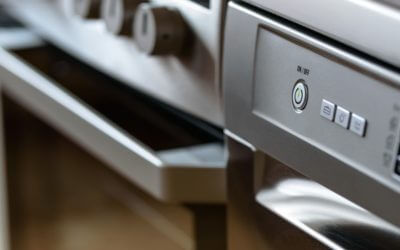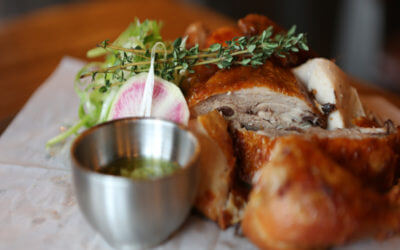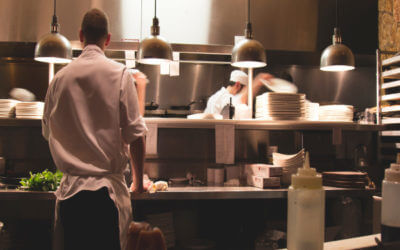4 Ways to Keep Your Restaurant Employees Engaged
March 18, 2019You can have everything you need to run an amazing restaurant – a great menu, incredible chef, the best location, perfect pricing, and top-of-the-line kitchen equipment.
But even with all of that, you won’t succeed if your employees are disengaged and unprofessional.
It can be a big challenge to keep your employees motivated and focused each day, but it’s something that has to happen. Your kitchen and front-of-the-house managers are the front line for this – and here’s what they can do.
Supply the Right Tools
A lot of the conversation around kitchen equipment has to do with keeping the customers happy. There’s nothing wrong with that, but unfortunately, sometimes restaurant owners and managers stop short when it comes to investing in staff needs.
Make sure the kitchen equipment that your employees need to be safe and comfortable is as important as diner-focused choices. For instance, padded mats for employees who stand in one place for a long time can make a big difference.
You also want your employees to have access to the technology they need. You should have booking, ordering, and payment software that makes the jobs of your staff easier.
Provide Training and Encourage Advancement
Is a waiter or waitress at your restaurant in a “dead-end job,” or are there opportunities for them to advance? Don’t make the mistake of assuming they don’t want more.
Almost everyone who has a job is interested in developing their skills and gaining promotions that include higher pay and more responsibility. If you don’t provide these options, not only will your employees be unmotivated and disengaged, they’ll be very likely to look for other jobs.
See your employees as people with careers rather than people with jobs. Teach them new things about your kitchen equipment. Help them develop, grow, and advance. You might find your next all-star manager when you put time and effort into your greeters!
Encourage Great Communication
Great communication can solve and prevent an untold number of problems. It starts at the top – your managers should always listen carefully when an employee shares with them. Whether it’s an FYI about a shift change or a more serious concern, managers should listen, respond, and remember to take action.
From there, encourage good communication between the front and back of the house. A lot of friction between these two staffing groups can be avoided if expectations are clear and problems are resolved quickly.
These great communication habits will naturally carry over to interactions with diners. This can help everything move more smoothly and your customers will leave happier than ever!
Get the Kitchen Equipment Your Staff Needs to Succeed
There’s a lot you can do to make your restaurant a great work environment, but it starts in the kitchen. Do you have the kitchen equipment your employees need to take and fill orders, communicate exceptions, and make payment easy?
If not, it’s time to take that step forward. Fortunately, we can help. From cooking equipment to smallwares, contact us for a quote today!
5 Things Every Restaurant Owner Should Do Before Buying Used Kitchen Equipment
Equipping your restaurant properly can cost a lot of money, so buying used kitchen equipment is the go-to choice for many restaurateurs. Buying used kitchen equipment for a restaurant is a bit different than buying used equipment for your home, however. You will...
Top Restaurant Technology Trends in 2018
When looking to buy restaurant supplies, you want to be on the leading edge of technology trends. This will keep your kitchen running smoothly. Let’s take a look at some of the most recent trends in restaurant supplies technology. 1. New Payment Options Who would...
5 Different Ice Shapes and Why You Should Care About Them
Ice makers are very popular in the restaurant and foodservice community because they eliminate the need to buy ice every day. And of course, adding an ice maker to your collection of foodservice equipment means you will always have ice on hand when you need it. An...
Pulping and Grinding: A Starter’s Guide to Reducing Commercial Food Waste Costs
For most restaurant owners and managers, the expenses involved in making meals are always under careful consideration. Water is needed to prepare, cook and wash food; power is necessary for food prep, cooking and cooling, and so on. However, how many of us consider...
Choosing the Right Milk Cooler: Cold Wall or Forced Air?
In a restaurant, milk is an essential to have on hand for coffee and other café-style beverages, for serving with kids’ meals, and as a key ingredient in many recipes. Keeping your milk properly chilled can be difficult without the proper restaurant equipment....
How to Choose Your Next Commercial Meat Smoker
The movies that connect with us on a personal level are the ones that linger in our memories forever. Anyone who has used a commercial meat smoker knows that they have a huge influence on the taste of a meal. You need to have just the right kitchen equipment to get a...
Are High Speed Ovens Too Good to be True?
You might have heard a few of the bold claims that foodservice equipment manufacturers have been making about high speed ovens, but they can’t be possible, right? Cooking three times as faster as regular ovens? Five times as fast? Fifteen times as fast? It may seem...
Choosing the Right Food Storage Containers for Your Restaurant
Choosing the right kitchen supplies will make a difference in your restaurant. Whether it is heavy duty kitchen equipment or food storage containers, each piece of equipment plays its own important role. Today, we are going to talk about how to choose the right food...
Tipton’s Guide to Perfect Poultry Trussing
Do you ever truss birds in your commercial kitchen? Trussing is a fantastic cooking technique because it makes poultry cook faster, look more attractive and taste better. If your commercial kitchen prepares poultry, you don’t want to miss these trussing tips. Trussing...
How to Eliminate Excess Condensation in Your Kitchen
Is your commercial kitchen getting steamy? If so, you could have more than just an uncomfortable working environment on your hands. Excess moisture in your commercial kitchen can result in the corrosion of equipment, the development of mold, and even damage to your...
The DIY Guide to Your Restaurant’s Own Garden
Stocking your restaurant supply with your own home-grown herbs and produce can truly bring your dishes to life. When it comes to food, everyone knows there’s nothing like homemade and home-grown. Having your own culinary garden, however large or small, can help you...
5 Reasons a Meat Grinder Will Set Your Burgers Apart
The more you do to prepare your foods in-house with the right kitchen equipment, the fresher and more flavorful your dishes become. There are all sorts of restaurants offering fast-food style burgers, but some diners are looking for the real deal. A fresh, juicy...
Pest Preventions to Implement in Your Commercial Kitchen
Restaurant pests: it’s something that few people want to think about. Like it or not, pest management is an essential consideration for every commercial kitchen. Offering food, shelter and water, the unprepared commercial kitchen naturally provides everything pests...
Choosing the Right Material for Your Cooking Equipment
Kitchens are very unique to their chef. Just like a car mechanic has a toolbox unique to them, so is the cooking equipment in a kitchen. And over time, the same cooking equipment become a natural extension of the chef. What tools are you using in your kitchen? It...
Kitchen Hacks for Your Home
Some people are naturally good at certain skills. We all know someone who is naturally book smart, athletic, or musically inclined. What makes you jealous of them is how easy they make tasks seem compared to you. One skill might be cooking. Your dream may not be...















